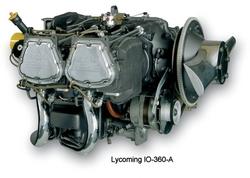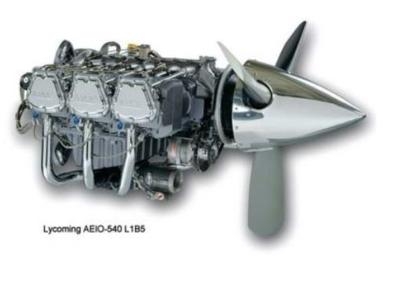Recommends Use Of Loctite On Idler Gear Set Screw
The FAA has issued a Special Airworthiness Information Bulletin (SAIB) concerning Lycoming Engines (Lycoming) O, IO, LIO, AIO, AEIO-320 Series; O, LO, IO, LIO, AIO, AEIO, TO, TIO-360 Series; O, IO, AEIO, TIO, LTIO-540 Series; IO-580 Series; and IO-720 series, wide cylinder flange engines, equipped with a front crankcase-mounted propeller governor.

According to the SAIB, wide cylinder flange engines are identified by the engine serial number suffix “A” or “E”. SAIB NE-08-32R1 is a complete revision that continues to recommend the use of Loctite 290 on the propeller governor idler gear shaft set screw in non-aerobatic engines, and adds a method of checking the security of the set screw without disassembling the engine.
Aerobatic engines using this set screw configuration are considered to have an unsafe condition because of the maneuvers performed at low altitudes that result in less time to recover in the event of an engine problem. AD 2015-02-07 mandates that a thread-locking compound is used on the set screw threads at each installation of the set screw.
During engine manufacture, overhaul, or any time the propeller governor idler gear shaft is installed in the engine crankcase, a set screw, part number AN565B1032H3, H4, or H5, is installed in one of the crankcase halves to prevent movement of the propeller governor idler gear shaft.
If the set screw comes out, it might interfere with moving parts of the engine causing significant damage. Without the set screw in place, the propeller governor idler gear shaft can move forward, and wear through the plug at the front of the crankcase. This will result in a loss of engine oil and an engine shutdown. In three of the reported accidents, engine oil was deposited on the windshield, restricting the visibility of the pilot during an emergency landing.
Lycoming issued Service Instruction (SI) No. 1343C, dated March 10, 2016, to continue the application of Loctite 290 on the set screw threads, and to clarify the peening procedure after the set screw is installed. Note that Loctite 290 is not applied instead of peening the threads in the crankcase; it is applied in addition to peening the threads in the crankcase. Lycoming has reported that since incorporating Loctite 290 into the process at their production facility and their overhaul facility in June 2007, there are no reports of set screws working loose or coming out of engines from these facilities. SI 1343C is also an Alternate Method of Compliance (AMOC) to AD 2015-02-07.
The FAA published SAIB NE-08-32, dated July 3, 2008, recommending the application of Loctite 290 when installing the set screw. In addition, the FAA has learned that some independent overhaul facilities have applied Loctite to set screws before Lycoming started applying Loctite on the set screw.

Lycoming published SI No. 1560, dated March 10, 2016, which provides a method of checking the security of the set screw without disassembling the engine. You can perform this optional procedure to check for movement of the propeller governor idler gear shaft as frequently as you wish. Prior to publishing SI No. 1560, the only way to determine the security of a set screw was to disassemble the engine.
SI No. 1560 does not include information on how to apply Loctite to the set screw. SI No. 1560 is not an AMOC to AD 2015-02-07. SI No. 1560 is a non-mandatory check for the security of the set screw and can be used to check aerobatic and non-aerobatic engines as frequently as desired.
Note that AD 2015-02-07, issued on January 13, 2015, only affects aerobatic engines and mandates the use of a thread-locking compound at each installation of the set screw. For aerobatic engines, applying a thread-locking compound is mandatory per AD 2015-02-07.
Lycoming did not apply Loctite to the set screws of aerobatic and non-aerobatic engines they manufactured and overhauled before June 2007. Lycoming did apply Loctite to the set screw of aerobatic and non-aerobatic engines they manufactured and overhauled in June 2007 or later.
For non-aerobatic engines, the FAA recommends that you apply Loctite 290 to the set screw each time the set screw is installed in the crankcase. Guidance for applying Loctite can be found in Lycoming SI No. 1343C, dated March 10, 2016.
For aerobatic and non-aerobatic engines, the FAA recommends that you check for the presence of the set screw at periodic intervals. Guidance for checking the set screw can be found in Lycoming SI No. 1560, dated March 10, 2016.
 NTSB Final Report: Evektor-Aerotechnik A S Harmony LSA
NTSB Final Report: Evektor-Aerotechnik A S Harmony LSA ANN's Daily Aero-Term (09.15.25): Decision Altitude (DA)
ANN's Daily Aero-Term (09.15.25): Decision Altitude (DA) Aero-News: Quote of the Day (09.15.25)
Aero-News: Quote of the Day (09.15.25) Airborne 09.12.25: Bristell Cert, Jetson ONE Delivery, GAMA Sales Report
Airborne 09.12.25: Bristell Cert, Jetson ONE Delivery, GAMA Sales Report Airborne 09.10.25: 1000 Hr B29 Pilot, Airplane Pile-Up, Haitian Restrictions
Airborne 09.10.25: 1000 Hr B29 Pilot, Airplane Pile-Up, Haitian Restrictions




